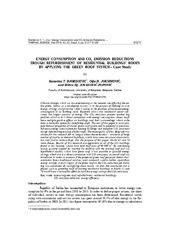Prikaz osnovnih podataka o dokumentu
Energy consumption and CO2 emission reductions trough refurbishment of residential buildings’ roofs by applying the green roof system: Case study
| dc.creator | Đorđević, Katarina T. | |
| dc.creator | Joksimović, Olja D. | |
| dc.creator | Jovanović-Popović, Milica Đ. | |
| dc.date.accessioned | 2020-12-01T12:58:53Z | |
| dc.date.available | 2020-12-01T12:58:53Z | |
| dc.date.issued | 2018 | |
| dc.identifier.issn | 0354-9836 | |
| dc.identifier.uri | https://raf.arh.bg.ac.rs/handle/123456789/1079 | |
| dc.description.abstract | Climate changes which we are experiencing at the moment are affecting the entire globe. Serbia, as a developing country, is in the process of defining its own energy strategy and priorities when it comes to the problem of increased energy consumption in its building stock. Research shows that residential sector consumes the largest quantity of energy. CO2 emissions present another big problem which is in a direct correlation with energy consumption. Green roofs have multiple positive effects on buildings and their surroundings which make them a desirable option for retrofitting roofs. The aim of this paper is to investigate thermal properties of chosen green roof system and its potential to positively influence energy consumption for heating buildings and therefore CO2 emissions trough refurbishing existing old flat roofs. New Belgrade was chosen for this research for its unique urban characteristics - existence of large number of similar or identical buildings, which have same structural characteristics and similar surroundings. For the purpose of this paper, blocks 45 and 70 were chosen. Results of this research are applicable on all of the 132 buildings found at this location, which have total roof area of 90990m2. By calculating energy quantity needed for heating the building with the existing roof and two hypothetical models, which have green roof, it was possible to quantify energy savings, which are in a direct correlation with CO2 emissions. A control roof was introduced in order to examine if the proposed green roof possesses better characteristics than a traditional solution, most commonly used in Serbia. Apart from energy savings, overall impact of the green roof on the CO2 reduction per building was calculated. By multiplying these results, we drew the conclusion that a project such as greening roofs of existing residential buildings in blocks 45 and 70 would have a noticeable effect on both the energy savings and CO2 emissions. | en |
| dc.language.iso | en | sr |
| dc.publisher | VINCA Institute of Nuclear Sciences | sr |
| dc.rights | openAccess | sr |
| dc.rights.uri | https://creativecommons.org/licenses/by-nc-nd/4.0/ | |
| dc.source | Thermal Science | sr |
| dc.subject | Extensive green roof | sr |
| dc.subject | Refurbishment | sr |
| dc.subject | Residential buildings | sr |
| dc.subject | CO2 emission reduction | sr |
| dc.subject | Energy efficiency | sr |
| dc.title | Energy consumption and CO2 emission reductions trough refurbishment of residential buildings’ roofs by applying the green roof system: Case study | en |
| dc.type | article | sr |
| dc.rights.license | BY-NC-ND | sr |
| dcterms.abstract | Јовановић-Поповић, Милица Ђ.; Ђорђевић, Катарина Т.; Јоксимовић, Оља Д.; | |
| dc.citation.volume | 22 | |
| dc.citation.issue | 4 | |
| dc.citation.spage | 1217 | |
| dc.citation.epage | 1229 | |
| dc.citation.rank | M22 | |
| dc.identifier.wos | 000450540300022 | |
| dc.identifier.doi | 10.2298/TSCI170530127D | |
| dc.identifier.scopus | 2-s2.0-85057085932 | |
| dc.identifier.fulltext | https://raf.arh.bg.ac.rs/bitstream/id/3735/bitstream_3735.pdf | |
| dc.type.version | publishedVersion | sr |

